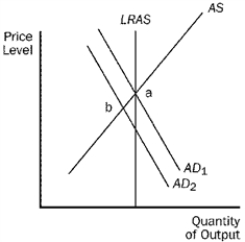A) increase government spending.
B) increase the money supply.
C) decrease government spending.
D) decrease the money supply.
Correct Answer

verified
Correct Answer
verified
Multiple Choice
Some economists argue that
A) monetary policy should actively be used to stabilize the economy.
B) fiscal policy should actively be used to stabilize the economy.
C) fiscal policy can be used to shift the AD curve.
D) All of the above are correct.
Correct Answer

verified
Correct Answer
verified
Multiple Choice
Critics of stabilization policy argue that
A) policy affects aggregate demand quickly,but the effects on aggregate demand are long-lived.
B) policy affects aggregate demand with a lag,and the effects on aggregate demand are long-lived.
C) policy affects aggregate demand with a lag,but the effects are short-lived.
D) policy does not affect aggregate demand.
Correct Answer

verified
Correct Answer
verified
Multiple Choice
Other things the same,during recessions taxes tend to
A) rise.The rise in taxes stimulates aggregate demand.
B) rise.The rise in taxes contracts aggregate demand.
C) fall.The fall in taxes stimulates aggregate demand.
D) fall.The fall in taxes contracts aggregate demand.
Correct Answer

verified
Correct Answer
verified
Multiple Choice
According to a 2009 article in The Economist,the multiplier effect and crowding-out effect would exactly offset each other when the economy is
A) operating at full capacity.
B) in recession.
C) experiencing zero inflation.
D) experiencing high rates of inflation.
Correct Answer

verified
Correct Answer
verified
Multiple Choice
During periods of expansion,automatic stabilizers cause government expenditures
A) and taxes to fall.
B) and taxes to rise.
C) to rise and taxes to fall.
D) to fall and taxes to rise.
Correct Answer

verified
Correct Answer
verified
Multiple Choice
Automatic stabilizers
A) increase the problems that lags cause in using fiscal policy as a stabilization tool.
B) are changes in taxes or government spending that increase aggregate demand without requiring policy makers to act when the economy goes into recession.
C) are changes in taxes or government spending that policy makers quickly agree to when the economy goes into recession.
D) All of the above are correct.
Correct Answer

verified
Correct Answer
verified
Multiple Choice
Suppose investment spending falls.To offset the change in output the Federal Reserve could
A) increase the money supply.This increase would also move the price level closer to its value before the decline in investment spending.
B) increase the money supply.However,this increase would move the price level farther from its value before the decline in investment spending.
C) decrease the money supply.This decrease would also move the price level closer to its value before the decline in investment spending.
D) decrease the money supply.However,this increase would move the price level farther from its value before the decline in investment spending.
Correct Answer

verified
Correct Answer
verified
Multiple Choice
For the following questions,use the diagram below:
Figure 34-7.  -Refer to Figure 34-7.Which of the following is correct?
-Refer to Figure 34-7.Which of the following is correct?
A) A wave of optimism could move the economy from point a to point b.
B) If aggregate demand moves from AD1 to AD2,the economy will stay at point b in both the short run and long run.
C) It is possible that either fiscal or monetary policy might have caused the shift from AD1 to AD2.
D) All of the above are correct.
Correct Answer

verified
Correct Answer
verified
Multiple Choice
For the following questions,use the diagram below:
Figure 34-7.  -Refer to Figure 34-7.The aggregate-demand curve could shift from AD1 to AD2 as a result of
-Refer to Figure 34-7.The aggregate-demand curve could shift from AD1 to AD2 as a result of
A) an increase in government purchases.
B) a decrease in net exports.
C) households saving a smaller fraction of their income.
D) a decrease in the price level.
Correct Answer

verified
Correct Answer
verified
Multiple Choice
Critics of stabilization policy argue that
A) there is a lag between the time policy is passed and the time policy has an impact on the economy.
B) the impact of policy may last longer than the problem it was designed to offset.
C) policy can be a source of,instead of a cure for,economic fluctuations.
D) All of the above are correct.
Correct Answer

verified
Correct Answer
verified
Multiple Choice
One of President Obama's first fiscal policy initiatives was
A) ARRA.
B) TARP.
C) QE1.
D) QE2.
Correct Answer

verified
Correct Answer
verified
Multiple Choice
According to the IGM poll,what percentage of economists polled agreed that the benefits of ARRA exceeded the costs?
A) 75%
B) 19%
C) 6%
D) 97%
Correct Answer

verified
Correct Answer
verified
Showing 61 - 73 of 73
Related Exams